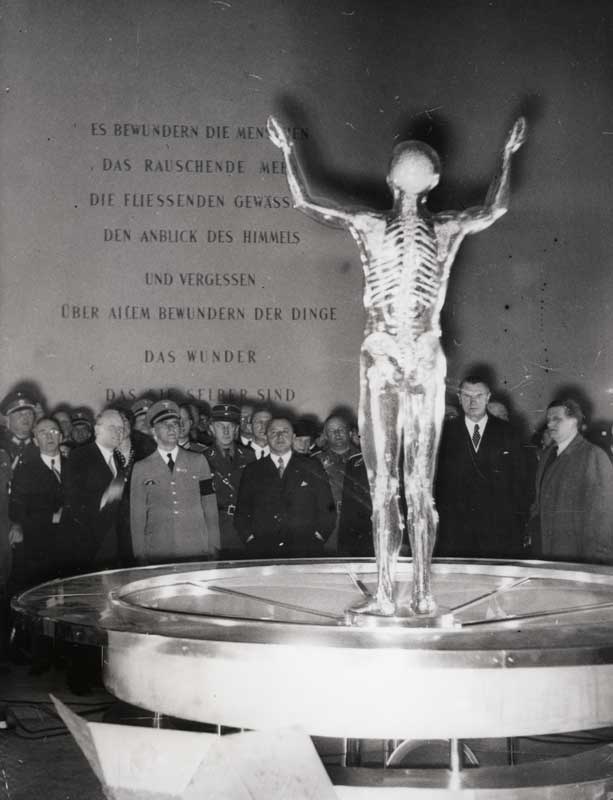




I have long been enthralled with the chilling Deadly Medicine: Creating the Master Race, a catalog for a touring exhibition of the same name organized by the United States Holocaust Memorial Museum. I have just found out that this exhibition is now on view right here in New York City, at the Museum of Jewish Heritage, through January 16th. If the catalog is any indication, this exhibit is simply not to be missed.
As a further lure, this Sunday, November 6th, the museum is hosting a fascinating looking symposium entitled "Medicine and Medical Ethics in Nazi Germany" preceded by a guided tour of the exhibition.
Full info follows for both exhibition and symposium; hope very much to see you there!
Deadly Medicine: Creating the Master RaceAnd the symposium:
On view through January 16, 2012
Museum of Jewish Heritage
36 Battery Place, New York City
“Nazism is applied biology.”
— Rudolf Hess, Deputy to Adolf Hitler
WASHINGTON, D.C. — The United States Holocaust Memorial Museum’s traveling exhibition, Deadly Medicine: Creating the Master Race, examines how the Nazi leadership, in collaboration with individuals in professions traditionally charged with healing and the public good, used science to help legitimize persecution, murder and, ultimately, genocide...
Eugenics theory sprang from turn-of-the-century scientific beliefs asserting that Charles Darwin’s theories of “survival of the fittest” could be applied to humans. Supporters, spanning the globe and political spectrum, believed that through careful controls on marriage and reproduction, a nation’s genetic health could be improved.
The Nazi regime was founded upon the conviction that “inferior” races and individuals had to be eliminated from German society so that the fittest “Aryans” could thrive. The Nazi state fully committed itself to implementing a uniquely racist and antisemitic variation of eugenics to “scientifically” build what it considered to be a “superior race.” By the end of World War II, six million Jews had been murdered. Millions of others also became victims of persecution and murder through Nazi “racial hygiene” programs designed to cleanse Germany of “biological threats” to the nation’s “health,” including “foreign-blooded” Roma and Sinti (Gypsies), persons diagnosed as “hereditarily ill,” and homosexuals. In German-occupied territories, Poles and others belonging to ethnic groups deemed “inferior” were also murdered...
Medicine and Medical Ethics in Nazi GermanyYou can find out more about the exhibition by clicking here and more about the symposium by clicking here. You can watch an exhibition overview video by clicking here. You can order a copy of the fantastic catalog by clicking here, or peruse it anytime in The Morbid Anatomy Library.
Sunday, November 6, 1 P.M.
Prof. Sander Gilman, Emory University; and Prof. Arthur Caplan, University of Pennsylvania; moderated by Museum Director Dr. David G. Marwell
Lectures by Prof. Gilman, a cultural historian who has written on Nazi science, and Prof. Caplan, a leading scholar in the field of medical ethics, will be followed by a conversation about the origins and legacies of Nazi medical practices.
$10, $7 students/seniors, $5 members
Co-presented by FASPE (Fellowships at Auschwitz for the Study of Professional Ethics). mjhnyc.org/faspe
This program has been made possible by a generous grant from the Conference on Jewish Material Claims Against Germany: Rabbi Israel Miller Fund for Shoah Research, Documentation and Education.
Presented in conjunction with Deadly Medicine: Creating the Master Race. Tour the exhibition at 12 P.M. Space is limited and pre-registration is required. Call 646.437.4202.
Images top to bottom:
- International Hygiene Exhibition, 1911 promotional poster: The eugenics movement pre-dated Nazi Germany. A 1911 exhibition at the German Hygiene Museum in Dresden included a display on human heredity and ideas to improve it. The exhibition poster features the Enlightenment’s all-seeing eye of God, adapted from the ancient Egyptian “Eye of Ra,” symbolizing fitness or health. Credit: Deutsches Historisches Museum, Berlin
- Students at the Berlin School for the Blind examine racial head models circa 1935. Students were taught Gregor Mendel’s principles of inheritance and the purported application of those laws to human heredity and principles of race. During the Third Reich, German born deaf or blind, like those born with mental illnesses or disabilities, were urged to submit to compulsory sterilization as a civic duty. Credit: Blinden-Museum an der Johann-August-Zeune-Schule fur Blinde, Berlin
- Head shots showing various racial types. Most western anthropologists classified people into “races” based on physical traits such as head size and eye, hair and skin color. This classification was developed by Eugen Fischer and published in the 1921 and 1923 editions of Foundations of Human Genetics and Racial Hygiene. Credit: United States Holocaust Memorial Museum
- Nazi officials at the “The Miracle of Life” exhibition, German Hygiene Museum, Dresden, 1935. The new Nazi museum leadership asserted that societies resembled organisms that followed the lead of their brains. The most logical social structure was one that saw society as a collective unit, literally a body guided by a strong leader. Credit: National Archives and Records Administration
- The head of a Jewish youth was sculpted from wood by the Jewish artist M. Winiarski for German officials in the occupied Polish city of Lodz. Credit: Zydowski Instytut Historyczny, Instytut Naukowo-Badawyczy, Warsaw


No comments:
Post a Comment